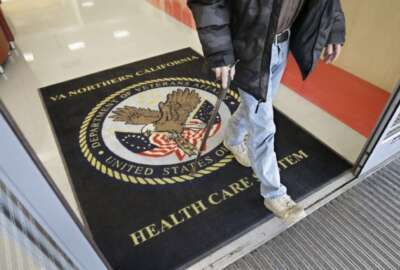Veterans Affairs’ IG offers advice for troubled electronic health record
The Department of Veterans Affairs and the Defense Department launched a new Electronic Health Record (EHR) at the Lovell Federal Health Care Center in Chicago.
Last month, the Department of Veterans Affairs and the Defense Department launched a new, interoperable Electronic Health Record (EHR) at the Lovell Federal Health Care Center in Chicago. It is the first big VA facility to use the EHR. During the deployment, the agency’s inspector general noticed a few challenges presented by the EHR scheduling system that could hamper the effort. For details, Federal News Network’s Eric White spoke on the Federal Drive with Tom Temin with VA’s Deputy Assistant IG Leigh Ann Searight.
Interview Transcript:
Leigh Ann Searight As you know, the EHR rollout took a pause in 2022 and then continued through 2023. But DoD was continuing with their implementation. And so because Lovell is a joint facility, VA and DoD wanted to implement the EHR at Lovell. And so we thought it was important to really look back at the prior implementations and look at the issues encountered, and then consider that for Lovell being that it is a more complex facility and the risks of that implementation at that facility.
Eric White So you’re almost trying to get ahead of the game and work yourself out of a job if a problem does arise later on.
Leigh Ann Searight I don’t know if we’ll ever get there.
Eric White All right. So the issue was pertaining to problems with the scheduling system that you saw at smaller facilities that rolled out the EHR. First off, If you could just lay out what is the scheduling system for the new electronic health record? Is it a unique scheduling system or what is it?
Leigh Ann Searight No, it’s part of the Cerner Oracle package. But scheduling is a critical element of gaining access to any facility or any appointment that you have. And so as focused as VA is on expanding access to facilities, scheduling has a whole level of complexity to it for VA because we, the VA, does so much more for its veterans as it coordinates and scheduling of employment. Us on the outside, maybe don’t get that coverage that they do that veterans get within the VA facilities. That coordination and collaboration between the schedulers and the clinics and the providers. There’s a lot of back and forth and a lot of nuance to those processes. And so that’s why there is complexity in the scheduling and why we wanted to focus on that.
Eric White Yeah, especially with the backdrop of scheduling has been an issue for the agency famously in the past couple decades. And probably one of the main complaints that you hear from people who are under the Veterans Affairs care. Does that stack up as we really got to get the scheduling part of this right?
Leigh Ann Searight Correct. What we found in our previous reviews on scheduling and on other reviews in the EHR space is that there are some nuances to these scheduling packages. For example, we identified issues with the displaced queue. So when a MSA works a schedule like for a provider, if that provider needs to take leave or if the provider leaves the organization, that creates a lot of complexity. And moving all those existing appointments that need to be rescheduled, canceling them and then rescheduling them. Under the old system, there were ways that they handled that. Under the new system, they had the ability to block out those schedules and then move them into what they call this displaced queue. So it was an efficiency. But what we found is that appointments seem to fall off of that queue, and nobody had that visibility to know that those appointments were lost. So maybe a veteran wasn’t aware that appointment was scheduled or rescheduled and shows up to the facility, and there’s actually no appointment for them, or they fall through the cracks completely and they don’t get rescheduled. And so it didn’t happen every time the displaced queue was used. And so there were fixes that need to occur. But those fixes weren’t happening fast enough. And so these five facilities that had already fielded EHR and started to work do their own workarounds, and everybody had a different workaround. And that’s not efficient either.
Eric White Yeah, I can’t imagine a workaround at a smaller facility is easier to discover than at a large facility where you find the workaround and that’s going to mess up 4 or 5 other appointment blocks. We’re speaking with Leigh Ann Searight from the Office of Inspector General for the Department of Veterans Affairs. And as always, when we’re talking about Veterans Affairs, staffing comes into play. You mentioned that is part of your concerns as well, that the level of staffing and overtime is not quite there yet to meet the free or regular deployment of the amount of appointment levels that are going to come from the implementation of the new EHR. What did you all have to find on that front?
Leigh Ann Searight So when we looked back at the five facilities that have already implemented EHR, and we found that they had beefed up their staffing quite a bit, or if they didn’t hire additional, they used an excessive amount of overtime to supplement that. And this was a somewhat cursory review. So we weren’t able to get into the depth of like why the scheduling takes up much more. We think there’s some complexities to the process. And like we spoke previously, we think facilities create all these workarounds because the rollout of EHRM and the challenges that they have, EHRM hasn’t done a good job of standardizing some of these issues, so that facilities are doing it the same. And so in creating your own workaround, you’re creating other processes. In addition, we found that some of the lack of standardization or decision on making changes to VA’s processes created additional work for VA as well for this schedulers. For example, facilities generally send out a mailing to every veteran for every appointment. You get a letter reminding you that you have an appointment so that you know, that helps manage our cancellation and no-show rates within the VA. But the new scheduling package doesn’t do that. And so our facilities were taking it upon themselves to come up with a solution, whether they created the letters themselves, whether they contracted that out. And so those issues result in more time and more effort. And so as not only learning a new system, but then having to do all these workarounds and deal with these challenges, we think are one of the contributing factors of why they need to hire so many more for these rollouts.
Eric White And let’s talk about the actual information within the electronic health record. We’re still having a persistent problem with inaccurate patient information. Is that coming just from the conversion from one system to this Cerner system, or is something else at play there.
Leigh Ann Searight With the rollout of EHRM, with the Cerner solution, it is a DoD and a VA. Each has their own systems, but the intent is for that interoperability. And so the federated system that feeds into this system is called DEERS, the Defense and Eligibility and Enrollment System. And so this system is where when you enter into DoD and you work through DoD, you have all your vital information, your address, all of that. So they’re using that as the source of information for veterans. But a lot of these veterans separated from the military many years ago and maybe don’t access years any longer. And so that information was out of date. And so VA and DoD have worked to clean up that information. But there’s still some misinformation between and misunderstanding and really a lack of awareness at the scheduler level that some of those issues have been fixed. So schedulers are still doing some of those workarounds that might or might not be necessary. So because of that communication issue.
Eric White And updated data entry means hey, we need more people to do that too. So you offered no recommendations on this one. Like I said, it was a little bit different from what we usually see from the IG. Was this more of just, hey, we want to make sure that VHA is aware of these issues as let’s take it a little bit slowly this time and know what’s going to be coming down the pipeline. Was that the intent here?
Leigh Ann Searight So what we issued was a management advisory memo. And so you’re right, we did not make any recommendations. That’s per that management advisory memo template. So really what we wanted to do is just summarize issues that we had already highlighted. We wrote a report in 2021 on the scheduling issue. We still have recommendations open from that. And we wanted to really summarize all the issues that we’ve seen and bring that to light. And so that VA had that information at their hand as they went to the Lovell fielding.
Eric White It’s called a management alert. But something that kind of, as you mentioned, summarizes everything. This could be something that a manager could pass down to those below him or her and say, hey, these are the things to watch out for. Would that be a good use of this document as well?
Leigh Ann Searight Absolutely. As VA continues to make decisions on the implementation of EHRM and improvements on the scheduling package, I think it’s a tool that they can refer back to. And for those facilities that have already implemented EHRM, the Cerner solution, I believe that they could use this to inform their workforce of the changes that have or have not occurred to be aware of that.
Copyright © 2025 Federal News Network. All rights reserved. This website is not intended for users located within the European Economic Area.
Eric White is news anchor and Federal Drive producer at Federal News Network.
Follow @FEDERALNEWSCAST






